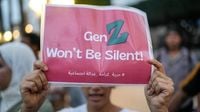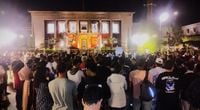For more than a week, Morocco has witnessed a groundswell of youthful protest that has swept through more than a dozen cities, shaking the North African kingdom’s reputation for political stability. Organized almost entirely online by a leaderless collective known as Gen Z 212, these demonstrations have drawn tens of thousands of young Moroccans into the streets. Their demands? Better public health and education, real job opportunities, and an end to what they see as government corruption and misplaced priorities.
Gen Z 212, whose name references Morocco’s international dialing code, is not your typical activist group. Its founders remain anonymous, and its operations are coordinated through Discord, a chat app more commonly associated with gamers than with political organizing. Yet, as reported by the Associated Press, the group has amassed more than 180,000 members, with spinoff collectives organizing locally and independently. This digital-first, decentralized approach has allowed the movement to spring up across the country, from the stately boulevards of Rabat to the bustling markets of Casablanca and the sun-washed avenues of Agadir.
What’s driving Morocco’s Gen Z to action? At the heart of the unrest are frustrations over a lack of opportunity and a sense that government spending does not reflect the pressing needs of ordinary citizens. According to France 24, Morocco is pouring more than $5 billion into infrastructure projects for the 2030 FIFA World Cup, building and renovating fourteen stadiums, expanding high-speed rail lines, and modernizing airports. Yet, away from the tourist routes and gleaming new facilities, many Moroccans struggle with soaring living costs, stagnating wages, and public hospitals and schools that remain chronically underfunded.
Unemployment is a particularly acute issue for Morocco’s youth. Over half of the population is under 35, and for those aged 15 to 24, the unemployment rate has climbed to 36%. A June 2025 Afrobarometer survey found that more than half of Moroccans under 35 have considered emigrating in search of better prospects. The sense of frustration is palpable. As one 27-year-old demonstrator, Youssef, told the Associated Press, “The government is taking patchwork measures to ease the pressure. Their reforms will take years.”
The protests have been fueled further by high-profile tragedies that underscore the country’s uneven development. In September 2025, eight women died giving birth at a public hospital in Agadir—an incident that ignited national outrage. Agadir, despite its renovated airport and status as a tourist destination, is the capital of one of Morocco’s poorest provinces. Residents there have long decried a lack of doctors and quality medical care. The country as a whole has just 7.7 medical professionals per 10,000 inhabitants, with even fewer in southern and eastern regions where the protests have been most heated, according to Royanews.
These disparities have become rallying points for protesters, who chant slogans such as “Stadiums are here, but where are the hospitals?” and “Freedom, dignity and social justice.” In cities like Casablanca and Tetouan, hundreds have gathered to demand “an end to corruption.” The movement’s demands have evolved over the past week. Initially centered on broad calls for dignity and social justice, Gen Z 212 published a letter addressed to King Mohammed VI, asking him to dismiss the current government, release detained protesters, and convene a national forum to hold officials accountable. Many demonstrators have directed their appeals to the king, seen by many as an anchor of stability, with shouts of “The people want the King to intervene.”
Morocco’s government, led by Prime Minister Aziz Akhannouch, has been caught off guard by the scale and persistence of the protests. Akhannouch, one of the country’s wealthiest businessmen, and Health Minister Amine Tahraoui have both come under fire from demonstrators, who accuse them of overseeing a corrupt system that prioritizes spectacle over substance. The magazine Jeune Afrique has reported that major business interests, including the royal family’s investment fund Al Mada, stand to profit substantially from World Cup-related developments, further fueling perceptions of inequality.
The official response has oscillated between crackdown and conciliation. On the weekend of September 27-28, 2025, riot police and plainclothes officers arrested scores of demonstrators, many of whom were minors. According to the Associated Press, when midweek demonstrations turned violent, police in a town outside Agadir fired on protesters attempting to storm a security post, killing three people on October 1. The night before, a police van rammed into protesters in Oujda, injuring one. The Ministry of Interior later reported that over 350 people, most of them security personnel, have been injured since the protests began. Despite these violent incidents, the majority of gatherings have remained peaceful, with Gen Z 212’s Discord channels filled with reminders to avoid vandalism and provocation.
After the initial crackdown, government officials shifted their tone. Akhannouch and several cabinet members expressed openness to dialogue, acknowledging the deep challenges facing the health and education sectors. Health Minister Tahraoui told Hespress, “The government launched a comprehensive plan from the beginning, and today we are accelerating its pace so that citizens can feel the improvements more clearly.” The Minister of Youth and Communication, Mohamed Mehdi Bensaid, reiterated the government’s willingness to engage with protesters, hinting at potential reforms. However, as AFP and other outlets have reported, skepticism remains high among the youth. Many see these overtures as attempts to defuse unrest without tackling the root causes—namely, the lack of transparency, accountability, and meaningful investment in social services.
The protests have also begun to affect Morocco’s global image and its vital tourism sector. Travel advisories have urged visitors to exercise caution and avoid protest zones in cities like Marrakech, Rabat, and Agadir. For a country that prides itself on its hospitality and cultural heritage, the unrest is a stark reminder of the social challenges that persist beneath the surface.
What sets Morocco’s Gen Z protests apart from earlier waves of unrest in the region is their digital, decentralized nature. Like similar movements in Madagascar, Kenya, Peru, and Nepal, Moroccan youth are bypassing traditional political parties and unions. They’re organizing online, making it difficult for authorities to predict or suppress demonstrations. This is not the Arab Spring revisited, but a new chapter in youth activism—powered by smartphones, solidarity, and a hunger for justice.
As Morocco races to prepare for the 2030 World Cup, the government faces a crucial choice: embrace the aspirations of its young citizens or risk deepening divides that could echo far beyond the newly built stadiums. For now, the future belongs to those who dare to demand it, and the world is watching to see which path Morocco will choose.

